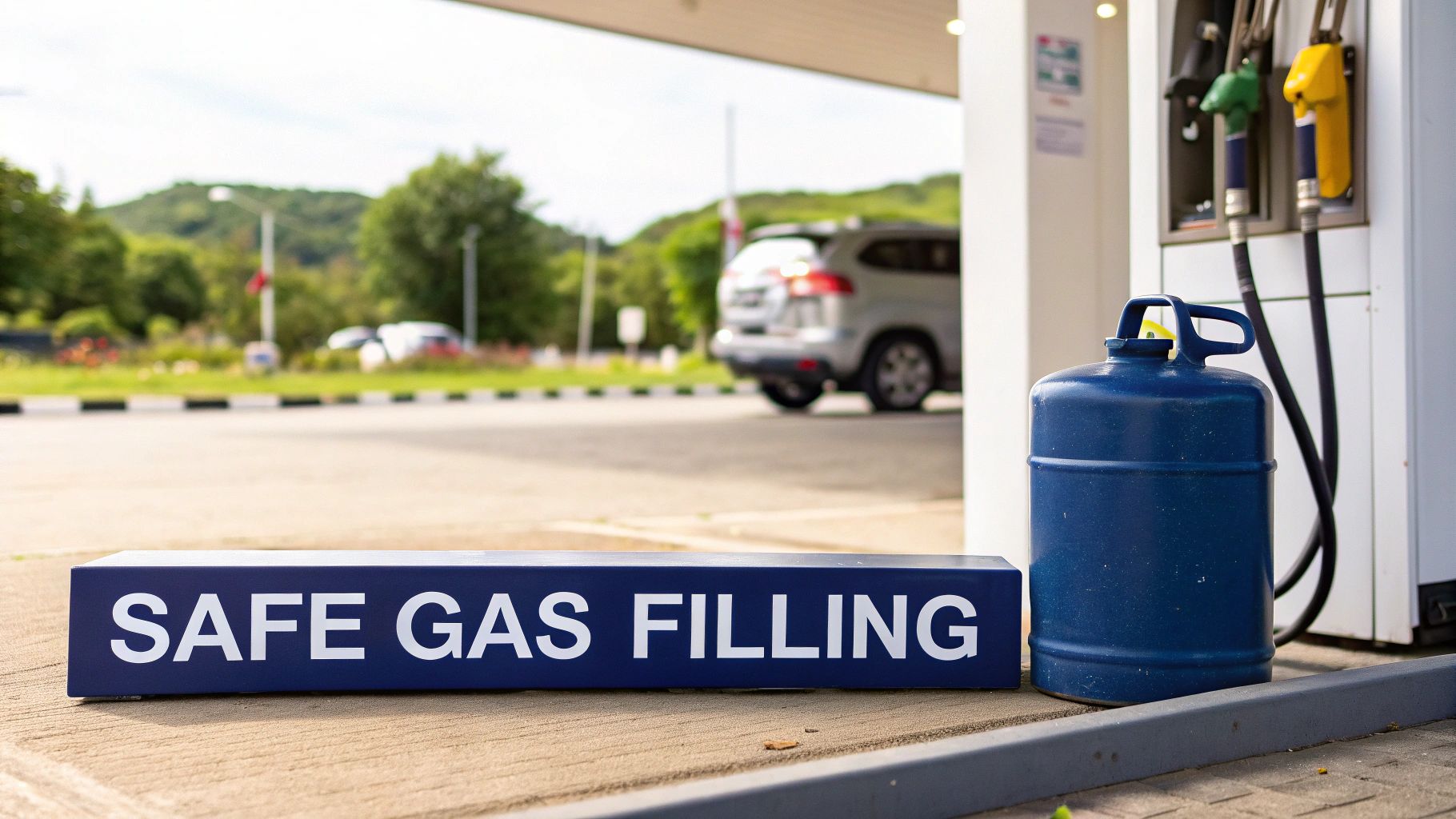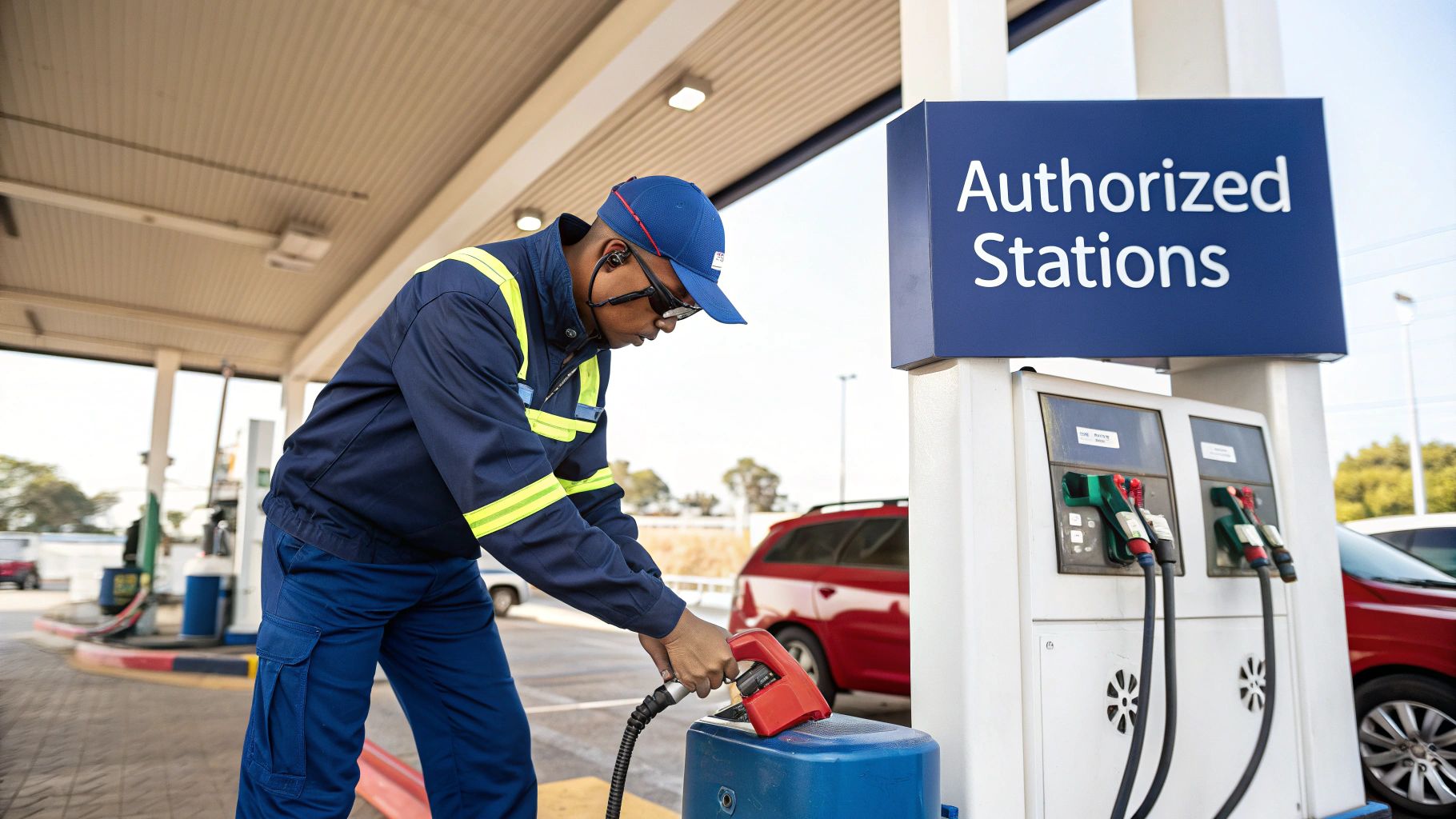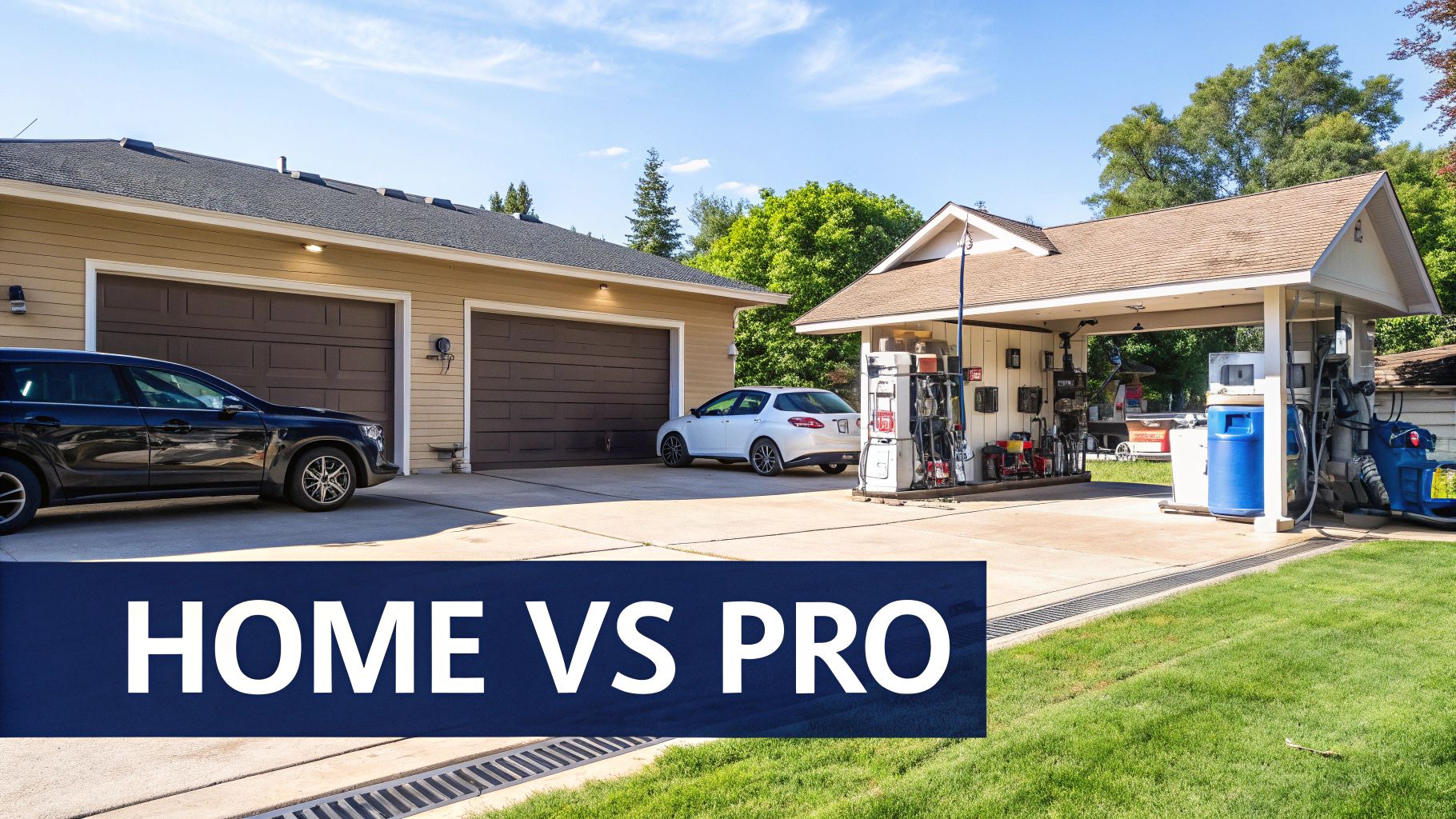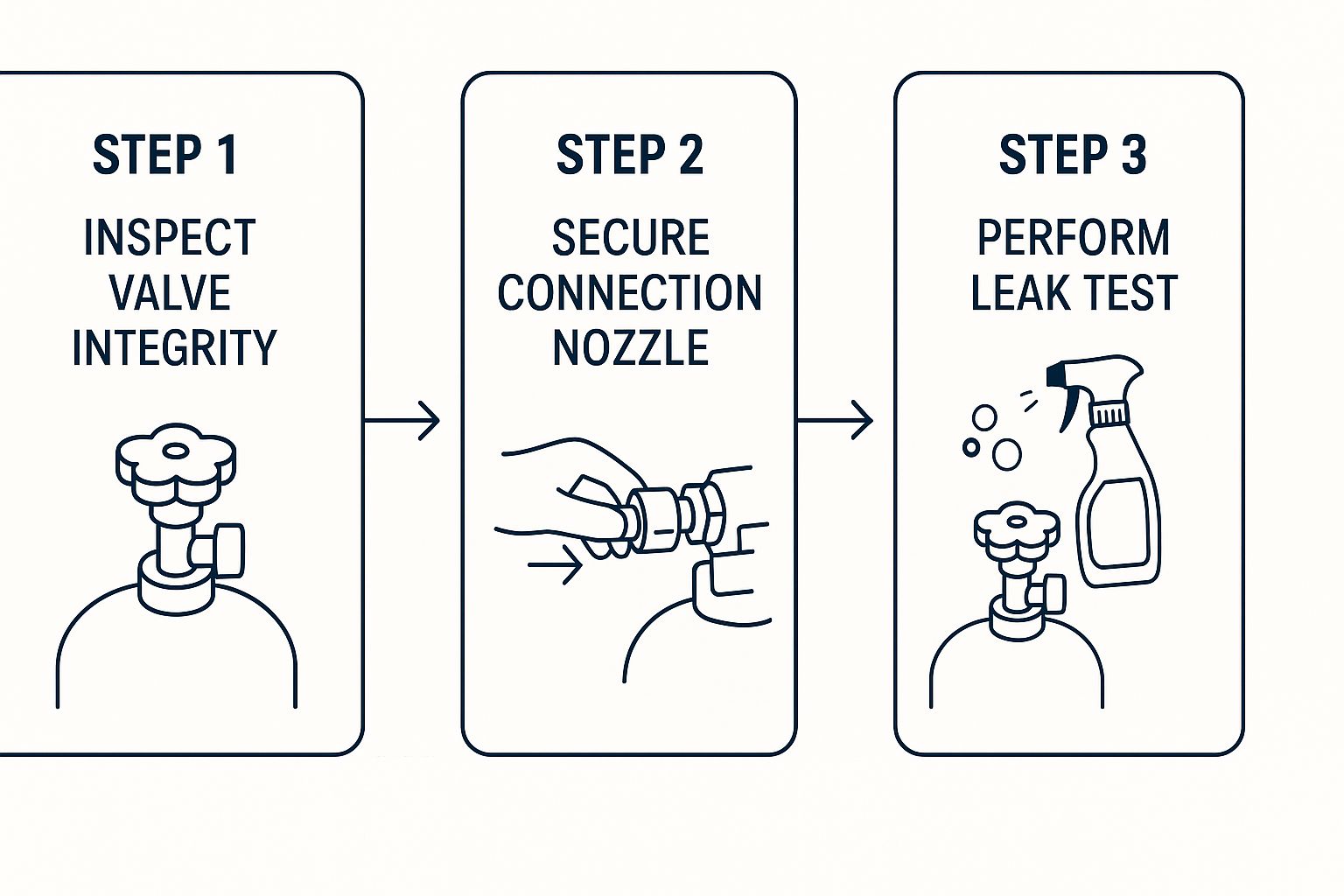When it comes to filling up a portable gas can, there's only one right answer: at a licensed gas station, with the can placed firmly on the ground. It might seem overly cautious, but this rule is non-negotiable for a very good reason—it prevents static electricity from turning a simple task into a dangerous fire.
Why The Location Is So Important

Knowing where to fill your gas can is the first and most critical step in fuel safety. While it seems obvious, the science behind it is what keeps you safe. A portable container isn't like your car's fuel tank; it's an ungrounded object that can easily build up a static charge.
This is exactly why you should never fill a gas can in your garage, in the back of your truck, or anywhere indoors. These spots don't have the built-in safety features of a gas station and are often full of potential ignition sources.
The Risks of the Wrong Location
Trying to fill a gas can anywhere besides on the ground at a pump is just asking for trouble. Think about these common but incredibly dangerous mistakes:
- Inside a Vehicle or Truck Bed: A plastic bed liner or even the carpet in your trunk acts as an insulator. This allows static electricity to build up on the can with no way to safely dissipate, creating the perfect setup for a spark.
- In a Garage or Shed: Gasoline fumes are heavier than air. They can sink to the floor and travel across the room to an ignition source you might not even think about, like the pilot light on your water heater or a spark from a power tool.
The guiding principle is simple: gasoline is highly volatile. The rules for handling it are all about controlling two things—static electricity and flammable vapors. Ignoring them is a gamble you don't want to take.
For a quick reference, here’s a look at where you should and shouldn't fill your gas can.
Safe vs Unsafe Gas Can Filling Locations
| Location | Safety Level | Primary Risk |
|---|---|---|
| On the ground at a gas station | Safe | Minimal risk when following proper procedure. |
| In a truck bed (especially with a liner) | Unsafe | High risk of static electricity buildup and spark ignition. |
| Inside a car's trunk or cabin | Unsafe | Extreme risk of static buildup and vapor accumulation. |
| In a garage, shed, or indoors | Unsafe | Extreme risk of vapors finding an ignition source (e.g., pilot light). |
Ultimately, following safety standards isn't just about following rules; it's about preventing a fire or explosion.
These guidelines are set for a reason. In the United States, organizations like the National Fire Protection Association (NFPA) have developed strict rules to manage static electricity and prevent the accumulation of flammable vapors. If you want to dive deeper, you can explore additional market research about portable fuel tanks to see just how common they are and why these regulations are so vital.
Why You Must Place Gas Cans on the Ground

Here's the single most important rule to remember when you're filling up a portable gas can: always place it flat on the ground before you start. This isn't just a friendly tip—it's a critical safety measure grounded in the simple physics of static electricity.
Ever shuffle your feet on a carpet and get a little shock from a doorknob? That’s a static discharge. Now, imagine that same spark happening right next to gasoline vapors. As fuel flows from the pump's nozzle into your can, the friction of the moving liquid builds up a static charge.
The Science of a Spark
When your gas can is sitting on the ground, that concrete or pavement provides a direct path for the static charge to safely disappear. It’s a process called grounding. But if the can is sitting on an insulated surface, that charge gets trapped with nowhere to go.
A classic and dangerous mistake is leaving the gas can in the bed of a pickup truck, especially one with a plastic liner. That bed liner is an insulator, effectively trapping the static electricity as it builds. Eventually, the charge gets strong enough to jump from the can to the metal fuel nozzle you're holding.
That tiny, almost invisible spark is more than enough to ignite gasoline fumes, causing a terrifying flash fire right at the pump.
Why Grounding Is Non-Negotiable
This is why certain fueling habits are so incredibly risky. Placing a gas can on any surface that insulates it from the ground turns it into a ticking time bomb.
Keep these common hazards in mind:
- Plastic Truck Bed Liners: This is the number one cause of static-related fires at the pump. Never fill a can in your truck bed.
- Carpets and Mats: Filling a can while it's in your trunk or sitting on a floor mat is just as dangerous.
- Direct Contact is Key: The can itself needs to be touching the ground. This ensures any static charge is neutralized the moment it's created.
Taking the simple step of putting the can on the ground completely eliminates this risk, making the whole process safer.
Once it's full, your next job is to seal it up tight. For more on what to do after you leave the pump, check out our guide on how to store gasoline safely.
The Unseen Danger: Why Gas Fumes Are the Real Threat

When we talk about fuel safety, most of us picture the liquid gasoline. But the real fire hazard isn’t the liquid—it’s the invisible vapor that comes off it. That’s the part that actually ignites.
Gasoline fumes have a sneaky habit. They're heavier than air, so they don't just float away. Instead, they sink and can creep along the ground, silently looking for anything that might set them off.
This behavior is exactly why the question where should I fill my portable gas can? is so important. Filling up in an open, breezy area lets these dangerous fumes scatter safely. Doing it in an enclosed space, however, is like setting a trap.
How a Spark Becomes an Inferno
Let's say you decide to fill your gas can in the garage to save a trip. You're super careful and don't spill a drop, but the whole time, invisible fumes are quietly spreading across the concrete floor. They can travel surprisingly far to find a spark.
Think about all the things in a typical garage or basement that could provide that spark:
- The pilot light on a water heater or furnace.
- A spark from a freezer or refrigerator motor kicking on.
- A stray spark from a power tool.
- Even a simple buildup of static electricity.
The explosive power locked inside gasoline is staggering. Vapors from just one gallon of gas can pack the same punch as more than a dozen sticks of dynamite. It's a sobering thought, and it's why you never want those fumes trapped indoors.
It's easy to see how a disaster could unfold. You might finish filling the can, thinking you've been perfectly safe, while those fumes are already making their way toward the furnace in the corner. That’s why filling up anywhere other than an open-air gas station is a risk you just can't afford to take.
Global Safety Standards and Legal Requirements
Following the right steps for filling a gas can isn't just a good idea to avoid an accident—it's the law. All over the world, safety organizations have created strict rules for handling fuel. These guidelines aren't just suggestions; they're legal requirements designed to protect everyone.
In the United States, for instance, organizations like the National Fire Protection Association (NFPA) and the Occupational Safety and Health Administration (OSHA) are the key players. Their rules aren't just pulled out of thin air. They're based on decades of hard data from fire investigations and accident reports, all aimed at one thing: preventing flammable vapors and static electricity from turning into a disaster.
This is exactly why the only legally approved and safe place to fill a portable gas tank is at a licensed gas station.
A Worldwide Commitment to Safety
This intense focus on safety isn't just an American thing. You can see a global agreement on how to handle fuel safely through international regulations and even the way infrastructure is built.
Take Europe, for example. Major investments have led to thousands of new fueling stations built to handle different fuel types under very strict supervision. These projects are about more than just convenience; they're designed to reduce risks and help meet big environmental goals, like cutting carbon emissions by 30% by 2030.
This global consensus proves that filling your tank the right way is part of a much bigger, worldwide effort. You can learn more about how fuel dispenser markets are evolving globally to meet these standards.
Key Takeaway: Fuel safety rules aren't arbitrary. They are globally recognized best practices. When you follow them, you're not just protecting yourself—you're doing your part in a shared responsibility for public and environmental safety.
These standards make sure that every time you fill a can, you're in an environment specifically designed to minimize risk. It reinforces the simple truth that these procedures are a shared responsibility for keeping our communities safe.
Your Step-by-Step Guide to Filling a Gas Can Safely
Knowing where to put your gas can is half the battle. The other half is knowing exactly how to fill it safely every single time you’re at the pump. This isn't just about following rules; it's about building a solid, repeatable routine that takes the guesswork out of handling fuel.
A consistent process is your best defense against a static-induced fire. It doesn't matter if you're filling up for your lawnmower or safely fueling your portable generator; the principles are the same.
The Six Steps to Safe Fueling
This isn't just good advice—it's the industry-standard protocol for a reason. Make these six steps a habit.
-
Turn Off Your Engine: First things first. A running car is a source of heat and potential sparks. Shut it off completely before you even think about grabbing the gas can.
-
Place the Can on the Ground: This is non-negotiable. Never, ever fill a gas can while it’s in your car trunk or the bed of your truck. The pavement acts as a ground, preventing dangerous static electricity from building up.
-
Discharge Your Own Static: Before you pick up the pump nozzle, touch a metal part of your car (like the door) away from the fueling area. This simple action gets rid of any personal static charge you might be carrying.
-
Keep the Nozzle in Constant Contact: Once you insert the nozzle into the can, make sure it stays touching the rim of the opening the entire time. This creates a solid connection that prevents a static spark from jumping the gap.
-
Fill Slowly to 95% Capacity: It’s tempting to squeeze every last drop in, but don’t. Leave about 5% of empty space at the top. This "expansion gap" gives the gasoline vapors room to expand with temperature changes, which stops pressure from building up inside the can.
-
Secure the Cap Tightly: As soon as you’re done, screw the cap on tight. A secure seal prevents both spills and fumes from escaping. Only after the cap is on should you carefully load the can back into your vehicle.
This infographic hits on some of the most important safety checks to perform.

As the visual guide shows, inspecting your gear and ensuring you have a secure setup are key. Each step in the process builds on the last, creating a simple but effective safety system. For an even deeper dive, check out our full guide on filling a gas container.
Common and Dangerous Fuel Handling Mistakes to Avoid
Knowing the right way to fill a gas can is one thing, but knowing what not to do is just as important. Some of the most common mistakes people make at the pump seem small, but they can quickly lead to incredibly dangerous situations.
One of the biggest culprits is simply overfilling the can. It's tempting to squeeze every last drop in, but gasoline needs room to breathe. As temperatures fluctuate, fuel expands and contracts, and filling a can to the very top creates immense pressure that can cause leaks or even make the container burst, especially if it's left in a hot car.
Always leave about 5% of the can empty. Think of it as a built-in safety margin.
Critical Errors That Create Ignition Risks
Another huge mistake is grabbing any old container. Never, ever use milk jugs, glass jars, or anything not specifically designed and rated for gasoline. These materials can break down from the fuel or, even worse, build up static electricity, turning a simple container into a serious fire hazard.
Along those same lines, you have to be vigilant about any potential sparks. It sounds obvious, but you’d be surprised. This includes things like:
- Smoking: A lit cigarette is a direct ignition source for flammable gas fumes. It’s a recipe for disaster.
- Using a Cell Phone: It's a rare event, but a phone's electronics can create a tiny spark. When you're dealing with gasoline vapors, a tiny spark is all it takes. Just leave it in your vehicle to be safe.
The golden rule of fuel safety is to eliminate every possible ignition source. A single spark from static, a cigarette, or even an electronic device is more than enough to ignite gasoline and cause a fire.
Finally, storing a filled can the wrong way is a common slip-up. Leaving it in direct sunlight or locking it in a hot car trunk can dramatically increase the vapor pressure inside. Spills aren't just a mess and an environmental problem; they're a massive fire risk.
If you do have a spill, knowing how to handle it safely is key. For detailed instructions, check out our complete guide on cleaning gasoline spills.
Got Questions About Gas Can Safety? We've Got Answers.
When you're dealing with gasoline, a little bit of know-how goes a long way. Let's clear up some of the most common questions about filling up those portable gas cans so you can do it safely every time.
How Full Is Too Full for a Gas Can?
You might be tempted to fill a gas can all the way to the top, but don't do it. The rule of thumb is to stop at about 95% full.
That little bit of empty space, known as "headspace," is your safety buffer. Gasoline expands in the heat and shrinks in the cold, and that headspace gives it room to breathe without building up dangerous pressure. Without it, the can could leak or even burst on a hot day.
Can I Just Fill the Can in the Back of My Truck?
This is a hard no. Always, always take the gas can out of your vehicle and place it flat on the ground before you start pumping.
Why? Static electricity. A plastic truck bed liner or even the carpet in your trunk can insulate the can, allowing a static charge to build up.
When the metal fuel nozzle gets close, that static can create a spark. A spark plus gasoline fumes is a recipe for a flash fire. Placing the can directly on the ground safely dissipates any static charge.
Is It Safe to Keep a Full Gas Can in the Garage?
It’s really not the best idea. Your garage is full of things that can create a spark, like the pilot light on your water heater or the motor in your freezer.
Gasoline fumes are heavier than air, so they can creep along the floor, find that spark, and ignite. If you have absolutely no other choice, make sure you're using a top-quality, approved safety can and store it in a well-ventilated spot, far away from any and all potential ignition sources.












